
- Source: Bomb Magazine
- Author: Sarah Lehrer-Graiwer
- Date: March 15, 2016
- Format: Print and Digital
Ryan Trecartin
by Sarah Lehrer-Graiwer
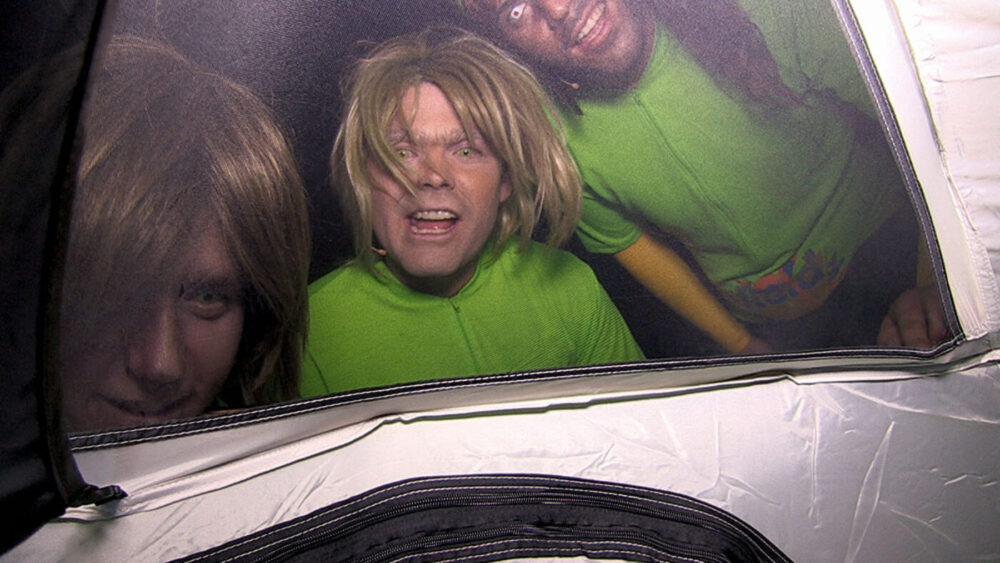
Lizzie Fitch/Ryan Trecartin, still from untitled work in progress. Copyright Lizzie Fitch/Ryan Trecartin. Images courtesy of Andrea Rosen Gallery, New York and Regen Projects, Los Angeles unless otherwise noted.
More than a decade of ontologically oracular and hilariously hyper-cogitated collaborative moviemaking has proven Ryan Trecartin to be a major and enduring force of contemporary culture—the flux capacitor powering our collective travels through various virtual realities. Since we last talked a few years ago, Trecartin’s been firing on all cylinders: with longtime creative partner Lizzie Fitch, he presented a multi-movie, multi-room installation called Priority Innfield at the 55th Venice Biennale in 2013. It was the beginning of a large, ongoing series of narratively linked movies, soundscapes, objects, and sculptural theaters that expanded the following year to include SITE VISIT at Kunst-Werke Institute for Contemporary Art in Berlin and Ledge at Regen Projects in Los Angeles. Oh, and I almost forgot, he also contributed to and co-curated the New Museum’s 2015 Triennial, Surround Audience, with Lauren Cornell.
I caught up with the artist at his LA studio, a low brick building on San Fernando Road with an expansive open workspace in back and a cluster of offices in front, where he was holed up editing new movies for the as-yet-untitled mega-project’s latest installment, which will be on view at Andrea Rosen Gallery in New York this spring. Littered with countless sticks of sweet-smelling palo santo, the editing room had a bay of computers in the middle and a bed in the corner for long nights. We settled in.
—Sarah Lehrer-Graiwer
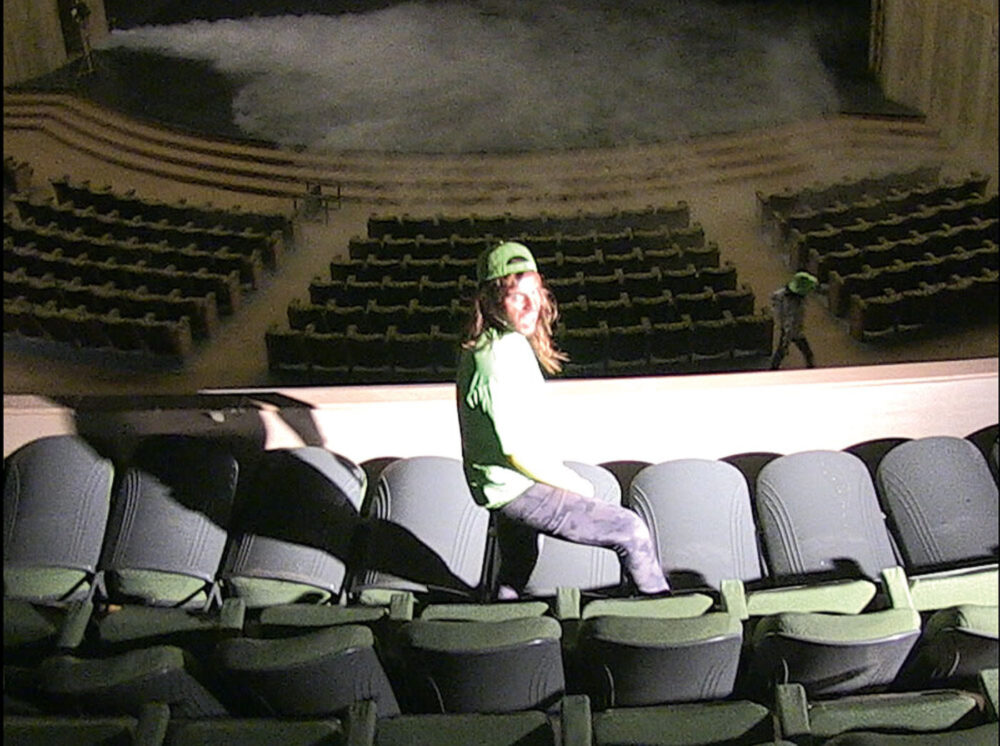
Lizzie Fitch/Ryan Trecartin, still from Site Visit, 2014, sculptural theater with 6-channel movie, 5.1 soundtrack, and multi-channel sound installation (total duration 49 minutes, 24 seconds). 3D Animations with Rhett LaRue. Dimensions variable. Copyright Lizzie Fitch/Ryan Trecartin. Courtesy of Andrea Rosen Gallery, New York, Regen Projects, Los Angeles, and Sprüth Magers, Berlin.
Sarah Lehrer-Graiwer
Last time we talked, in early 2013 or something, you were in the middle of editing a new piece, as you are now. It’s a strange time to talk about the work because so much happens in editing. And about a minute ago you were telling me how, this past year, you moved studios and your home.
Ryan Trecartin
Yeah, we did a ton of moving. We moved our house to Burbank, and then we moved our Burbank studio to Glassell Park. We originally rented our last house to double as a studio, but for the Venice Biennale project, we needed a studio to create those particular sets. We ended up liking having a studio in which we could build sculptures and different things that don’t work in a domestic setting. We go in and out of wanting a separate studio space. Right now we want one, but I can feel us already going back to wanting a house and getting rid of the studio. (laughter) Moving’s fun.
SLG
Moving’s fun? Who says that? (laughter) Moving’s the worst.
RT
I was getting depressed about the fact that I lived in that Los Feliz house for five years. Even growing up, I’ve never lived in a house longer than that. I don’t like making projects in the same places.
SLG
Like a new place is inspiring and exciting for ideas, even if it’s just an empty warehouse?
RT
Yeah, even if there’s nothing culturally different about it. It can be architecture that changes and that’s it. We’ve been talking about moving to a different city again.
SLG
This makes me think of your interest in people born in the mid–’80s and their relationship to media. Now that generation is growing up. Maybe it’s not yet happening in your circle, but these past couple years, a lot of friends are having babies, you know?
So I wonder, Can ways of living stay the same? Do you want them to? This settling down, employing people, having a staff—is it part of getting older and your interest in the generational?
RT
Well, I’m not really interested in things staying the same.
SLG
Even if your mode is constant change.
RT
It doesn’t yet feel like settling down, but if it did, I might not like it. We’re not interested in the same things as before—I say we meaning a lot of different things, but right now I’m talking about Lizzie and me primarily. When it comes to youth, I’ve always enjoyed it as a topic or a mode, and not necessarily as an age-related thing. It’s more about the relationship to self and culture, and negotiations of freedom.
Although I do think about when people were born in sort of an algorithmic way. It’s interesting that people born at different moments in time have different relationships to ideas. It doesn’t mean everyone in that age group has the same relationship—there’s the general flow and then the margins.
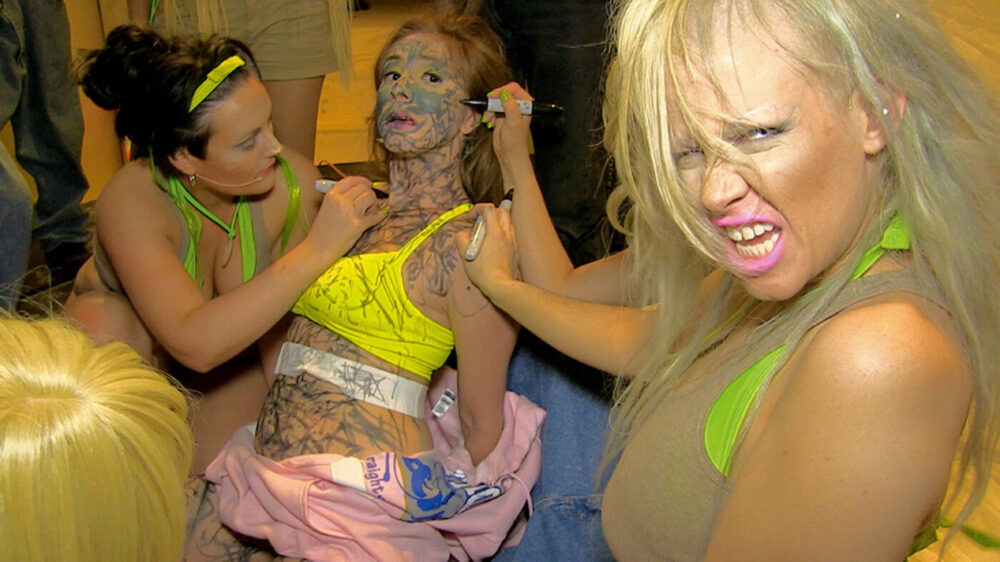
Still from CENTER JENNY, 2013, HD Video, 53 minutes, 15 seconds. Copyright Ryan Trecartin.
SLG
Youth as an attitude or a relationship to freedoms or self-formation makes sense. This is a side note, but I want to say that reimmersing myself in your work reminds me just how much it affects me on the level of permissiveness and what’s possible. It’s amazingly generative.
RT
K-Hole, who were in the Triennial, wrote something on the youth mode that’s like what you’re describing.
SLG
You’ve busied yourself with looking at a wide range of practices and artists, having co-curated the Triennial. I would imagine that is very different from being in the studio. What was that process like?
RT
I’m still digesting the experience. Working with Lauren was amazing. She traveled a lot, and did so many studio visits. Then she would present them all and we would talk about them. She really allowed me to continue being an artist. I got to glean all this amazing research and have a huge say in it, which was incredible. And that opportunity came at a moment when the artists we were researching were not that far from me generationally. But my mind is far from that right now …
SLG
If it’s too far away, we’ll move on.
RT
I think it’s important not to be too focused on past work when you’re creating new work, so I have purposely been trying to forget stuff temporarily. Like, I practice forgetting things, and then I have to try to remember them again later.
SLG
How does that work?
RT
Something’s a thought-loop, so I picture it and then I remove it.
SLG
Can you do that all in your head? Or do you keep a notebook?
RT
I do, but I don’t go back and read my notes much.
SLG
At least once you get an idea down, then you can let yourself forget, because it’s down somewhere.
RT
I mean, I love remembering, too—but sometimes you have to forget in order to grow. Or something will reemerge because you pushed it away, and it comes back in a different form. That’s a big part of the way we make movies. Things that we thought were over sneak back in a different form, even just words and phrases.
SLG
So this new work that you’re editing uses footage shot at the Masonic temple on Wilshire Boulevard, the one that the Marciano brothers are turning into a museum.
RT
Remember when we first met, I was talking about starting a new phase?
SLG
Yes, CENTER JENNY (2013) was the beginning of a new large body of work.
RT
Well, the catalyst for this new phase was Junior War (2013), and CENTER JENNY was part of that. That thing sprawled the fuck all over, and we’re still in that phase, basically.
The temple is this strange building that has the logic almost of a convention center and of all the spaces in a hotel that aren’t hotel rooms. It’s like a club; there are these big hallways that are way too big, and no windows.
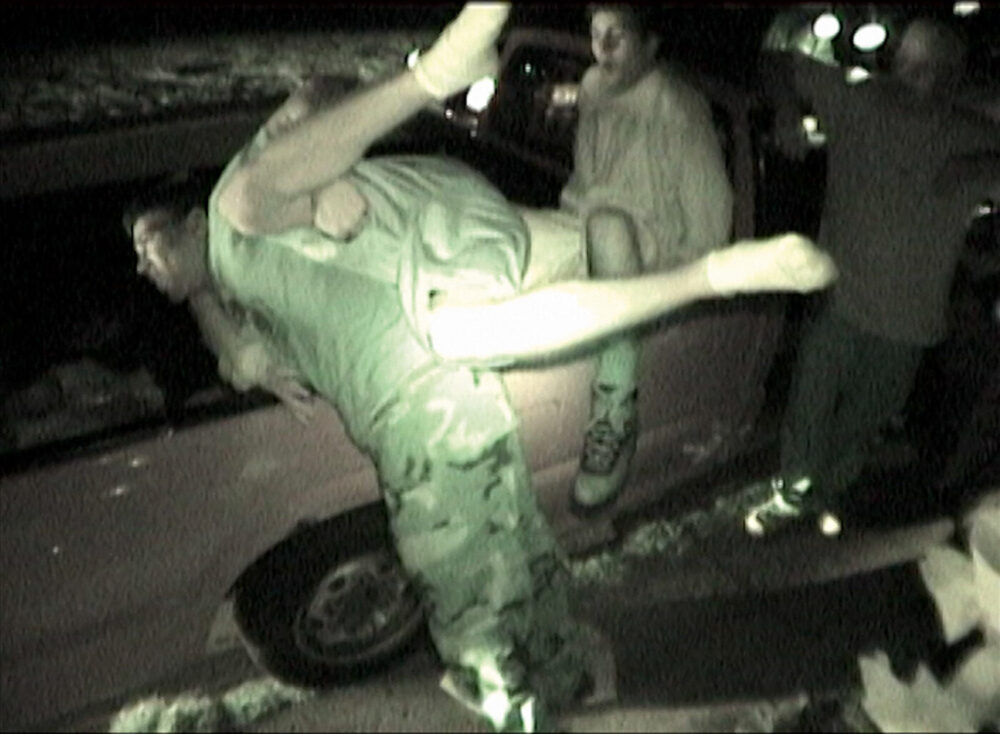
Still from Junior War, 2013, HD Video, 24 minutes, 25 seconds. Copyright Ryan Trecartin.
SLG
Did you know you were going to be shooting at the temple when you were doing CENTER JENNY and the movies that made up the Priority Innfield (2013) installation?
RT
No, not at all. The opportunity actually came from Maurice Marciano seeing Priority Innfield in Venice. He had just gotten the temple. It was the most amazing gesture. He gave us the key, basically, and said, “I’m going to demolish the inside of this, do whatever you want until we start the renovations.” It was an actual free-for-all for three months. He left us alone and gave us an opportunity to be creative—
SLG
—and take a hammer to the mirrors and the sinks.
RT
Yeah, there were just a couple of obvious rules, like, “Don’t destroy the mosaics,” which we wouldn’t have done anyway, so it all flowed perfectly. That space hijacked the project. It threw in this other element, and then the whole thing expanded.
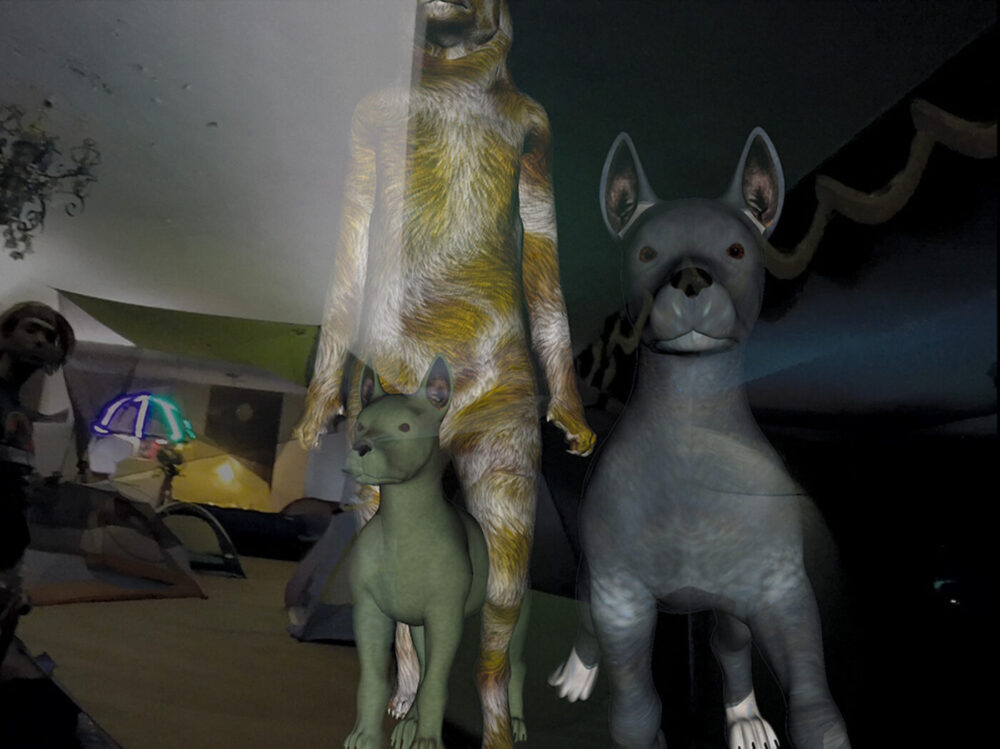
Lizzie Fitch/Ryan Trecartin, still from Site Visit, 2014, sculptural theater with 6-channel movie, 5.1 soundtrack, and multi-channel sound installation (total duration 49 minutes, 24 seconds). 3D Animations with Rhett LaRue. Dimensions variable. Copyright Lizzie Fitch/Ryan Trecartin. Courtesy of Andrea Rosen Gallery, New York, Regen Projects, Los Angeles, and Sprüth Magers, Berlin.
SLG
You and Lizzie had mapped out a big trajectory for the work and knew what was going to happen in upcoming installments, and then that changed.
RT
I don’t know if it’s subconscious, but we always throw in something that completely changes projects. Then it’s like we’re making something for the first time again. I’m glad it happens, but there are a ton of movies from that footage that have never been edited …
SLG
From the temple, or from before?
RT
From before, from the Burbank shoots. I still plan on editing them. There’s also this character, Mark Trade, who Murphy Maxwell plays—we did a road trip right after Venice and shot a bunch of stuff with him. We returned to the lake where we’d shot Tommy Chat Just E-Mailed Me in 2005, and shot some scenes there. A long time ago we started to film a movie there that we never edited. So this new body of work has footage from different years: from 2013 to now, from 2005, and even from high school. I don’t think this is going to wrap up the way Any Ever (2009–10) did. After the Andrea Rosen Gallery show and the show that DIS is curating at the Berlin Biennale, there will still be more that we can make from this body of work. We might just move on and then come back to it later, who knows? There’s always stuff on the cutting room floor. I can’t believe I said “cutting room floor”!
SLG
There’s nothing on the floor anymore. (laughter) So this body of work has become extremely open-ended.
RT
Yes. We developed it so we have more to mine later on.
SLG
Both the Burbank shoot and the temple shoots?
RT
Yeah. Part of them being inspired by this night-vision footage from high school has to do with the relationship to the camera. A few years ago, we were starting to think about new capture technologies as well as syncing software and 360-degree cameras, and the way cameras like GoPros, for example, can be put in multiple places. We developed a 360-degree set to capture stuff in the surround. People have gotten really savvy about how to act for a single camera; everyone has their own palette of languages and modes of behaving and interacting with a single camera. When you throw into the mix a whole bunch of different capture technologies, all activated at the same time, people are in a new space again—they don’t know how to act for a virtual-reality setting yet. It’s funny, in Burbank, when we first started shooting in this way, planning to sync a ton of cameras, this thing would happen where everyone shooting would end up sort of in the same spot, almost getting the same shot. I was still coming out of a way of directing that was for the single shot, for the edit.
Then once we got into the temple shoots, we’d already had that experience, so the people with the cameras would kind of drift off and get distracted constantly. Everyone had this mentality that someone else was capturing what needed to be captured, which freed them up. There are so many shots where the person’s acting, and no one’s capturing it. People were capturing these other things.
SLG
That’s amazing.
RT
So there was a shift in the primary focus of an action. We started focusing more on context as being the main character of the movie, rather than on individual personalities. And we used different characters and their behaviors as tools and utensils for the free will of the context rather than of the individual.
SLG
Oh, wow.
RT
So it became really hard to edit. (laughter) It’s producing a different editing language for us. Everything feels new again.
SLG
Were the temple shoots the first time you used GoPros and drones?
RT
Yeah, and on the road trip. In Burbank we used cameras, mics, and a bunch of different small handheld cameras that were consumer-friendly, go-on-a-vacation, home-movie style cameras; they weren’t coming out of the extreme-sports communities.
Then Lizzie started getting obsessed with all the gear people use—survivalist gear, eco-tourism gear, stuff like that. One day she just bought a drone, and we became obsessed with it. We got little ones, big ones.
SLG
Are there still bigger, industry cameras being used in the temple, or is it all drones, GoPros, and portable cameras?
RT
In the temple we pretty much used all these very portable ones, and things like the 5D-cameras, which are portable too. They can do so much, but I hate using them because they don’t have autofocus while you’re shooting.
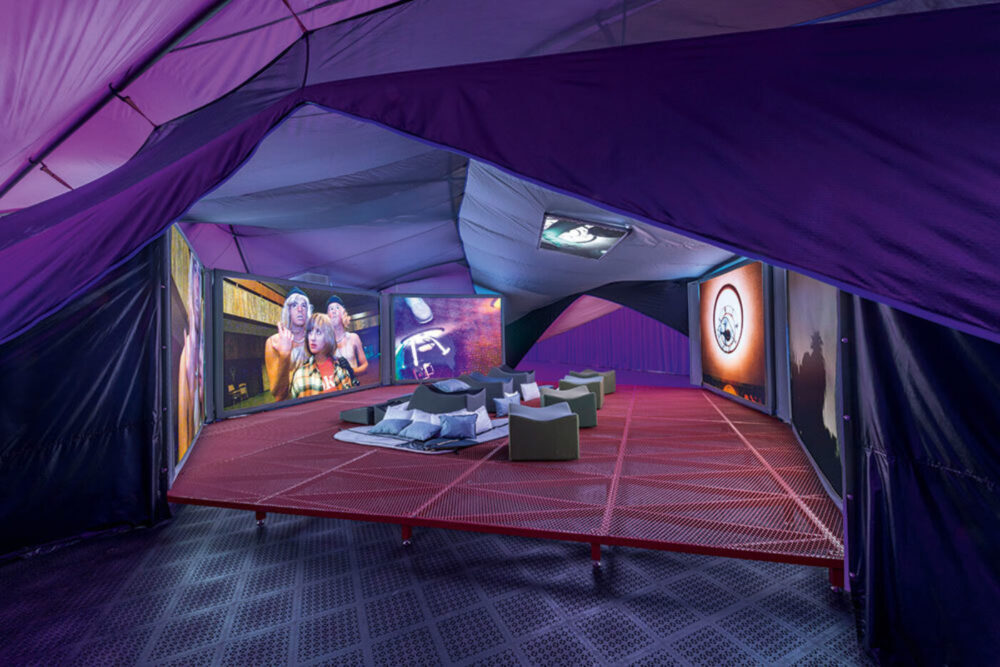
Lizzie Fitch/Ryan Trecartin, Ledge, 2014, sculptural theater with 6-channel HD Video and 5.1 soundtrack, 3D animations with Rhett LaRue, 49 minutes, 24 seconds, dimensions variable. Copyright Lizzie Fitch/Ryan Trecartin. Photo by Joshua White.
SLG
I read in the press release for Ledge that there were up to fourteen cameras shooting a scene. The effect is intense. And it seems like a logical extension of your ideas questioning where a self even lies, or on the multiplication of points of view that creates a hive mind, or a collective vision. You said the context became the priority, more than any story or individual. Are context and collective sight the same thing?
RT
No, but they’re related. In the temple shoots, for instance, one of the themes is that different layers of time and different realities coexist in the same location. There are these characters in gaming outfits—they’re all in green with a target on the back, referencing first-person shooter games. I was thinking of them as Anticipators. They’re almost the equivalent of a wallflower at a party; their mode is to anticipate and define the limits of a given reality, but they aren’t necessarily engaged. They verge on becoming hosts, but they aren’t quite hosts, so they’re ghosts, you know? And they aren’t players either.
SLG
Are they a bit different from the Witness category of characters in Priority Innfield who wear the same sweatshirt and carry cameras?
RT
Yeah, but it’s relative. There’s this idea of bird-watching as a metaphor for surveilling surveillance, basically watching back. One of the layers in the temple is a historic national park full of tickle animals—animals that went extinct appear in animated, user-friendly mode. And there are people in this area referred to as Natural Citizens too; it’s a play on words.
SLG
Natural Citizens?
RT
Yeah, citizenship combined with the word natural is a little twisted. The character Mark Trade, who is a Natural Citizen from this place, is always talking about bird-watching. The Anticipators sort of define the parameters of a situation. They have access to all the layers of the temple, and they talk about time as if things are going to happen and also as if they’ve already happened simultaneously. They are almost like the access class—they have access to everything—but in their zombie state, all they can do is articulate their authority and their privileges. They end up not really having any authority.
SLG
They don’t effect change.
RT
They can’t. To do so they would have to actually become involved with one of the realities, and if they did, they would no longer be able to witness the entirety of all the realities. Then they’d be players, or guests, and would no longer be in this sort of omni-ghost mode. Ideas about permissions and privileges show up in this body of work a lot, not just in the way we think of privilege in the culture—as in white privilege—but also in terms of what the word can mean in different contexts. Like in software, there are permissions.
SLG
Settings, all those kinds of things.
RT
Yeah, so I am trying to explore power dynamics and how some people get and use their power, paralleling that with ideas of evolution, pets, dogs, and how things become domesticated. Those are the big themes. I’m also interested in the feeling of being trapped, and in using helplessness recreationally.
How people get different forms of access is not really explored in these movies, it’s just implied that almost all the characters are proxies, in some way. They’re a bit stagnant and lack the fluidity of the characters in Any Ever—they’re pawns, but they’re being accessed somehow, and the Accessors are always talking about things in terms of feelings.
SLG
Are the Accessors the Anticipators, or are they different classes?
RT
It’s unclear on purpose, because I want people to wonder if these roles and modes are inherent to different characters, or if they are just shells and proxies. And if they are just the parameters of those shells, can anyone access those shells? That part is explored more in the Venice work …
SLG
Well, the idea of characters being ambiguously themselves or just a temporary vessel to access is certainly something you’ve primed us for in previous works. There’s a total instability as to what a self or an I or a person is, and it seems like it could change in the blink of an eye. A character could be as determined by a certain wig as by a line of dialogue as by a contact lens—these different cues temporarily designate character, and identity is pretty fluid.
RT
We’re following the transformations of the character less now—the focus is on the structure. But thinking about, say, I-Be Area (2007), in that piece, I-Be goes through different transformations. You’re following the linearity of I-Be sprawling throughout the movie, following the concept of that person, the accumulation of that person’s existence, and the way it’s maintained through all of its shared experiences. Whereas now, we’re looking at the vessel much more, like in a game.
SLG
Like an avatar.
RT
Yeah, like an avatar.
SLG
When you were describing the temple shoot, you said there are different coexisting realities. How do parallel realities relate to physical space?
RT
When I was scripting this work, I was thinking of it almost as an abandoned area. You know, these haunted-house movies where a group of teenagers go to a place they’re not supposed to and spend a night there. They start with a dare or an urban legend. Everyone acts like it’s a joke, but they’re still a little scared. So I started thinking about these scary movie tropes with all this different capture technology, and about how at some point we’re going to be able to capture not just different viewpoints but the raw data of an entire experience. Potentially, we will capture how different people in a room are feeling, how their feelings are generated, and also their various relationships to atmosphere, texture, color …

Lizzie Fitch/Ryan Trecartin, still from Site Visit, 2014, sculptural theater with 6-channel movie, 5.1 soundtrack, and multi-channel sound installation (total duration 49 minutes, 24 seconds). 3D Animations with Rhett LaRue. Dimensions variable. Copyright Lizzie Fitch/Ryan Trecartin. Courtesy of Andrea Rosen Gallery, New York, Regen Projects, Los Angeles, and Sprüth Magers, Berlin.
SLG
Is this where you see virtual reality going?
RT
Way down the line, yeah. There could be a merger of future virtual reality technologies and future capture technologies. If the multiplicity of subjective experiences in a single instance can be recorded, what would that do to memory? What would the role of remembering anything be? In terms of different events, which would mean more: the actual things that happened or the way everyone felt when they happened? It will be so easy to see what actually happened that the interpretation will always be more interesting.
The same goes for experiencing something from different perspectives. If you can actually recall other people’s experiences and go through them yourself, then maybe in the future it will be offensive to talk as if you’re not the same as someone else.
SLG
Far out, but I get it.
RT
What were we talking about?
SLG
I asked if these different realities are tied to geographical space. Does physical space mean anything?
RT
You know how people talk about making an architecture in your head where you can place things as a way to remember them? It actually works.
SLG
You’ve done it? The memory palace is from the Greeks.
RT
Yeah, I naturally do that.
I was thinking about these containers of recollections, where somebody can access a period of time and experience it from all these different perspectives. If time can be recorded in such an expansive way, then the future and the past will completely merge into one sprawling form. Both will be as set in stone as they are malleable, because if you can navigate something that already happened and alter it and create versions of it, how’s that any different from a new event, whatever that might mean? So I was thinking about these structures and how they could be equivalent to a haunted house or an abandoned building. Like an abandoned piece of the recollection is mismanaged, it doesn’t add up, it has holes in its capture technology.
SLG
Every recollection is like that.
RT
Yeah, but imagine if it weren’t like that, and then you have an experience that isn’t fully formed. Potentially you’d lose your ability to pull out, or stay part of that experience. You would not be able to switch between modes anymore because you’d get locked into a role or a loop.
SLG
Because there are bugs in the system. Is that scary to you? I never get the sense that there’s judgment attached to any of these developments you are anticipating. That’s comforting, because a lot of these speculations you’re offering feel so ominous and potentially ripe for abuse and manipulation.
RT
Everything is. It’s part of the culture. It’s not like this isn’t already happening.
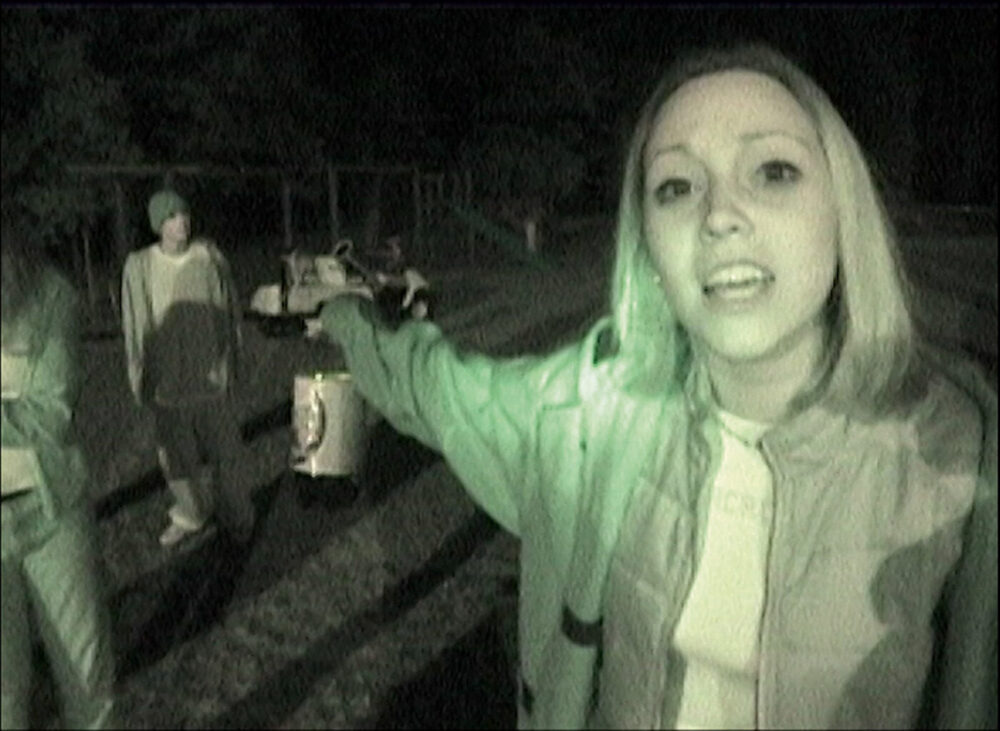
Still from Junior War, 2013, HD Video, 24 minutes, 25 seconds. Copyright Ryan Trecartin.
SLG
I want to hear about the animations and the tickle pets.
RT
During the Burbank shoots, which led to CENTER JENNY, Comma Boat (2013), and Item Falls (2013), animation was a big thing. It’s been the theme in all of our movies, though I’ve always thought of animation conceptually. Animation is part of our evolutionary arc as a species; it’s still primitive—the seeds of a complicated relationship that we’re going to have with artificial intelligence.
I’ve always been interested in ideas of companionship and in pet culture and the way in which different people view animals. There are therapy dogs, emotional support dogs, incredible news stories about evolution and how maybe dogs domesticated humans instead of the other way around … And then cats have such a different relationship with us—their relationship to the Internet is so interesting. They have a stronger domesticated relationship to the Internet than they do to us.
SLG
Isn’t there a symbiotic parasite in cat poop that makes humans act crazy?
RT
Maybe. I mean, I’m obsessed with cats. We have four.
SLG
There are moments when science and weird voodoo actually match up.
RT
Yeah, I believe it. With the tickle animals, I was thinking about what would happen if we started altering species for everyone to get along better. All dynamics would be similar to those between dogs and people, or cats and people.
I don’t know why I came up with the term “tickle animals.” It has to do with cartoons or the animated version of a dynamic. Like back when we were kids there were a lot of people who thought it was problematic that Disney was making polar bears smile and stuff like that. But what if there were de-extinction? What if we started bringing back these super-friendly species, with all the predatoriness taken away?
SLG
They’d be domesticated in relation to what we want: our pleasure. But there’s a two-way street of evolution—the animals would be engineered to become tickle animals and, at the same time, we as humans would be evolving in response to that.
RT
This is just an idea of one of the layers inside of this recollection. The temple is also a national park—a government’s attempt to preserve a bunch of natural concepts. The idea of trying to preserve something in its natural state is an oxymoron, in a way, because to preserve nature, we’re required to, like, make a pet of it. And you’re acting as if you are not part of nature.
SLG
The quarantining of nature is already messing with it. So, I was wondering about the tents in the natural habitat that’s abandoned—
RT
The national park, yes.
SLG
They relate to the park and nature, but also to squatting, settlements, Occupy, encampments.
RT
We’re using Occupy and an apocalyptic setting too, that’s why there’s this tent-row vibe.
SLG
A character refers to it as a disaster center.
RT
They’re constantly referring to the space as if some big event happened. It’s like there are all these docents roaming around describing different histories. It’s the idea of big history folding back on itself and becoming this niche thing. And people are constantly kicked out of factions and such. It’s like the dynamic of the Occupy movement. I liked thinking about that word literally. To occupy something. To occupy a sensation or a history and then to be kicked out of it and be squatting near it and trying to reinvest in it. Once you’re out of it, you almost become a reality show version of it, because you’re constantly describing it—but who’s listening to you? It’s like you’re generating another reality.
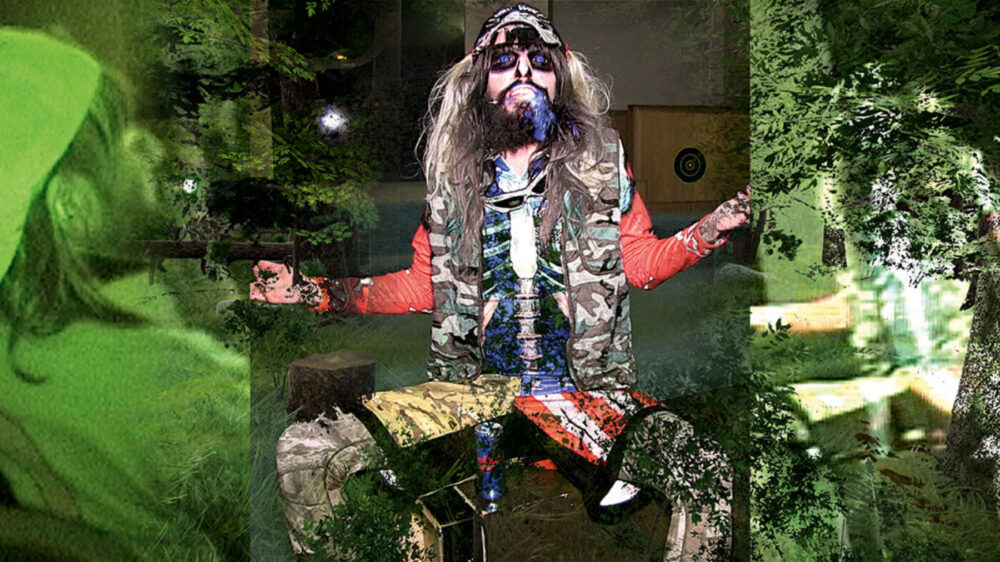
Lizzie Fitch/Ryan Trecartin, still from untitled work in progress. Copyright Lizzie Fitch/Ryan Trecartin.
SLG
It becomes almost like a news broadcast, too. Occupy for sure comes up when you see the tent row in the temple, but also the current refugee crisis, and displacement—all of that seems wrapped up in it.
RT
Yeah, and that weird continuum or blurring between the kennel, a zoo, a prison, or a camp. The word camp is so eerie. It could be all the things you just mentioned.
I can show you a little clip I was just working on. (Pulls up video clip on computer.) See how it has that kind of educational-video vibe? The Anticipators are constantly explaining their perspective instead of just doing stuff. In our past movies, characters explain something as if the audience was not separate from them, but explanation in the new work often gets stuck in broadcast mode, where a character talks at someone and not with someone, as if trying to reassert the fourth wall. It feels intentionally like a throwback, almost like a different way of talking is haunting the current moment.
SLG
It’s like a classic reality-TV thing. Not unrelatedly, the characters also talk a lot about shit and turtle heading. An animation of a dog illustrates this for us at a certain point. What do you want to say about that?
RT
With the animated dogs in the movie, the idea of turtle heading is used as a metaphor for being on the verge of something and staying there—like placing a hold on it and indulging in the hold. It’s also the idea that having a bond with something on the verge of happening is so addictive that things are stopped from happening.
Think of it like parties. There are two kinds: those that are really fun because they weren’t planned, and the ones that were planned and were so much fun. But when you think about these second ones, the fun part was actually everything right before the party. It’s like the post-production and pre-production are more interesting. I’m always trying to stay in the state of pre- and post-production.
Sarah Lehrer-Graiwer is a writer, curator, and educator in Los Angeles. In addition to contributing to Artforum and numerous exhibition catalogues, she publishes Pep Talk, co-runs the non-commercial exhibition space The Finley, and is the author recently of Lee Lozano: Dropout Piece (Afterall Books, 2014).

